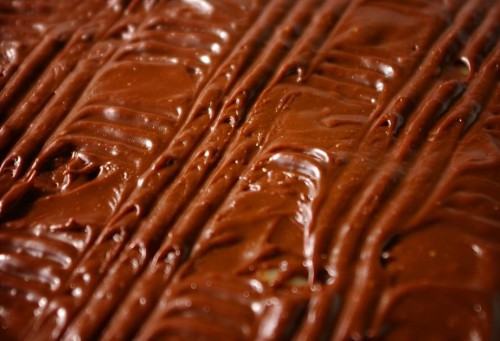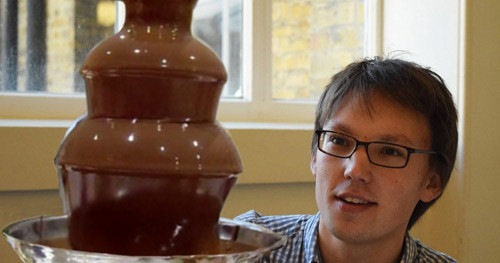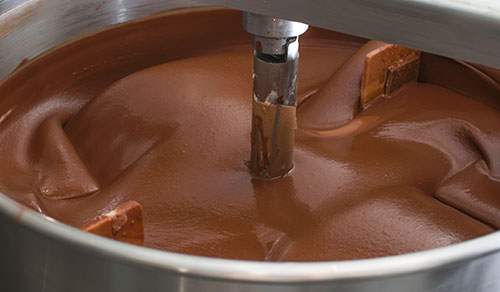Tag archives: chocolate
Cutting the fat from chocolate

Go with the flow: physicist Rogjia Tao has a clever way to cut the fat in chocolate. (CC BY-SA 2.0/rore)
By Matin Durrani in Baltimore, Maryland, US
A couple of years ago my colleague James Dacey decided to give up eating chocolate, crisps, biscuits and cakes over Lent and it’s a virtuous – if very dull – decision I’ve been following every year since (even if James has long since strayed from the path of righteousness).
It was therefore with a dollop of smug satisfaction that I attended a talk at this year’s APS March meeting by Rongjia Tao – a physicist from Temple University in the US. He has developed a way of cutting the amount of fat in chocolate without, apparently, losing any of the taste.
Now, reducing the fat content in chocolate might seem straightforward – you just get rid of the fat, right? But it’s a harder problem than you’d think for chocolate manufacturers, who have to send liquid chocolate – a suspension of spherical cocoa particles in a melted fat of cocoa butter and other oils – down pipes and tubes.
Dipping into the physics of a chocolate fountain

Dark flow: Adam Townsend ponders the dynamics of a chocolate fountain. (Courtesy: London Mathematical Society)
By Tushna Commissariat
When most people look at a chocolate fountain in a restaurant or maybe at a party, they are mostly thinking about all the yummy treats they can dunk into the liquid-chocolate curtain. But when a physicist or a mathematician looks at one, they can’t help but notice some of the interesting fluid dynamics at play – most visible is how the curtain of chocolate does not fall straight down, rather it pulls inwards, and that melted chocolate is a non-Newtonian fluid.
University College London (UCL) student Adam Townsend decided to work on this topic for his MSci project and has now published a paper on his findings in the European Journal of Physics. To study the inflow effect, he looked into some classic research on “water bells”, where the same flow shape is seen. “You can build a water bell really easily in your kitchen,” says UCL physicist Helen Wilson, who was Townsend’s MSci project supervisor and the paper’s co-author. “Just fix a pen vertically under a tap with a 10p coin flat on top and you’ll see a beautiful bell-shaped fountain of water.”
View all posts by this author | View this author's profile
Chocolate dynamics, recycling urine, the hipster-physicist look and more

Cocoa conch: a chocolate’s distinctive flavour and texture comes from “conching”. (Courtesy: iStock/deyangeorgiev)
By Michael Banks, Tushna Commissariat and Matin Durrani
Chocolate, the food of the gods, is more popular now as a sweet treat than ever before. And while more and more people know their 70% cocoa from their truffles, “lecithin” still isn’t a word that pops up often. It is an ingredient that plays a key role in chocolate-making and other foods. But this fatty substance has long confounded food-scientists and confectioners alike – we don’t know how this ingredient works on a molecular level and confectioners have had to rely on observations and trial-and-error methods to perfect recipes.
Now, though, chocolatiers have had help from an unexpected field – that of molecular biology – to figure out chocolate “conching” – the part of the chocolate-making process where aromatic sensation, texture and “mouthfeel” are developed. In a special issue on “The Physics of Food” published in the Journal of Physics D: Applied Physics, Heiko Briesen and colleagues at Technische Universität München, Germany, use molecular dynamics to model and simulate how lecithin molecules, made from different sources, attach to the sugar surface in cocoa butter. “I’m quite confident molecular dynamics will strongly support food science in the future” says Briesen.
View all posts by this author | View this author's profile
Sticky fingers no more

Chocolate that doesn’t melt until as high as 50C could be a boon for chocoholics in the tropics. (Courtesy:iStockphoto.com/alle12)
By Tushna Commissariat
“Look, there’s no metaphysics on Earth like chocolates” – Fernando Pessoa, Portuguese poet
It’s Easter again and shops in many countries are full of chocolate eggs and other gooey, chocolate-based treats. But why is it that certain tropical countries like Nigeria consume only small amounts of chocolate, despite producing most of the world’s cocoa? Indeed, nearly 70% of cocoa is grown in West Africa and the rest in Central and South America and Asia.
One of the main reasons is that the high tropical temperatures make chocolate lose its form while being transported within these areas. The chocolate can also undergo a “bloom formation” – a mouldy-looking white coating that forms on the surface resulting from an increase in temperature, which makes storing chocolate a problem.
But, once again, physics is providing a solution. Scientists have been looking at ways to create a “thermo-resistant” chocolate that holds its form and still tastes just right. And it looks like O Ogunwolu and C O Jayeola, food scientists at the Cocoa Research Institute of Nigeria have finally managed it, and just in time for Easter too. They found that adding varying amounts of cornstarch and gelatin to chocolate ensured that the chocolate melted at about 40–50 °C, instead of its normal melting point at about 25–33 °C. And the best bit is that, by all accounts, it still looks and tastes like normal chocolate!
The chocolate industry has been looking into ways of perfecting heat-resistant chocolate for a long time. For example, the US company Hershey’s developed a chocolate bar that was heat resistant and could be used as part of emergency rations for American troops during the Second World War. The down side was that, according to troop reports, the chocolate tasted “a little better than a boiled potato”. While Hershey’s did try other recipes and even managed to make a bar that melted only at 60 °C, reactions to the taste were mixed. So it is hoped that this new recipe will make chocolate more available to everyone, the world over, as it should be.
In other chocolate-related news, take a look at the slew of videos on YouTube that include researchers at the University of Nottingham conduct “Eggsperiments” with Cadbury’s Creme Eggs. My favourite one has chemists making quite a mess in their labs when they try to deconstruct the eggs.
View all posts by this author | View this author's profile